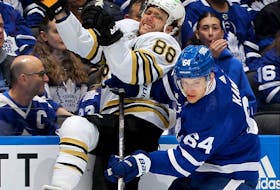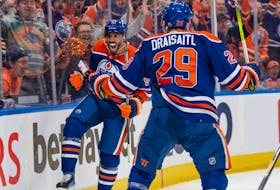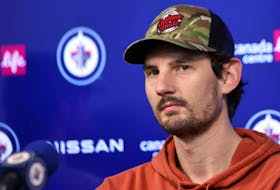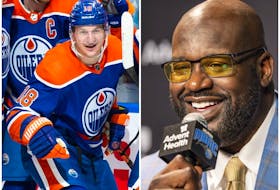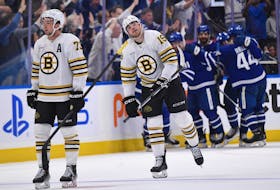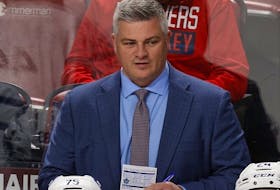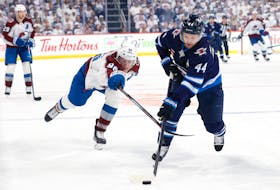Related story
However, the first-ever appearance by an NHL team playing on an outdoor rink before a paying audience happened 60 years ago today in Bay Roberts.
That’s when the Boston Bruins, on a barnstorming tour of Newfoundland, took on teams from the Conception Bay North Senior Hockey League on the new artificial ice at the Conception Bay Sports Arena.
The arena was also popularly known as Bennett’s Rink, after Fred Bennett, a local businessman who initiated construction of the facility in western Bay Roberts in 1955.
The idea was to have it fully enclosed, but when the arena officially opened in February of 1956, it was open-air and so it was when the Bruins descended on the town two months later on the sort of day you might expect in Newfoundland in early April.
“It was drizzly, and it was that foggy you could hardly see anything,” said Gerald Saunders, who would score the only goal against Bruins goaltender and future Hall of Famer Terry Sawchuk.
In fact, one of the most indelible memories of those who took in the contest was of Sawchuk holding an umbrella over his head.
Some say Sawchuk had been gifted with the umbrella by a local in a display of both Newfoundland hospitality and good humour. Research by Randall Maggs, the Corner Brook literature professor who wrote the classic ‘Night Work: The Terry Sawchuk Poems,’ suggests it was Bruins captain Fern Flaman who had borrowed the umbrella from a lady in the stands and brought it to his damp goaltender.
Whatever the exact details, there is no doubt Sawchuk found himself with some extra protection beyond what he normally wore in a scene that added some levity to balance the affects of the dreary weather.
There were plenty of such light moments, beginning when Bruins winger Fleming Mackell took the puck and skated the length of the ice only to switch directions, return to the Boston end and proceed on a similar rush into the opposition zone. Mackell, who would again be brought to Newfoundland by hockey a decade later as playing coach of the St. John’s Capitals, also engineered a unique trade, described by John Parsons, who was at the game, to Newfoundland hockey historian Bruce Chafe.
“A fellow from Country Road, Bay Roberts, Ray Caravan, and myself were standing together,” wrote Parsons. “It was cold and kind of damp that night and we were all wearing ‘scoot’ caps (hats with ear flaps). Some of the Bruins were wearing similar caps with the teams name (emblazoned) across the front of their caps. At one point, the “great” Fleming Mackell skated towards us and grabbed Caravan’s cap. He then put on Caravan’s ‘dirty’ old cap and gave Ray Caravan his cap. He then skated away and did not return. Ray Caravan was happy with the trade, and I was ‘pissed’ because I would have gladly traded my old cap for Fleming Mackell’s Boston Bruins cap. What a souvenir!”
•••••
Wilbur Sparkes, who later would become mayor of the town, normally played with the Bay Roberts Rovers, one of the teams that populated the Conception Bay North league, which over the years had also included the Shearstown Tigers, Coley’s Point Pointers and Brigus Bruins, as well as entries from Harbour Grace and Carbonear.
But on this day, he did not suit up. As a member of the local Kiwanis club, he had been tasked to “look after” a player, in his case Bruins’ forward Bob Armstrong. Nevertheless, Sparkes found himself somewhat a participant.
“I was sitting in the penalty box (area) with a stick that had a puck taped to it,” recalled Sparkes, “and Hal Laycoe (the Boston playing-coach on the tour) grabbed it from me. He skated down the ice, stickhandling past everyone and towards (goaltender) Gordon Snow, who came out sliding with his pads stacked and (Laycoe) got around him and put the puck and stick into the net.”
The matchup was unique in that it called for each of the local league’s teams to play a 10-minute period against the Bruins, but Saunders described it as mostly, “a fun game.”
“They would put a forward line and we’d put a line with them, swapping sides, you know,” said Saunders, a member of — as he described with pride six decades later — “those fierce Tigers” from Shearstown.
Parsons related about how Sawchuk skated down the ice to score on his Shearstown counterpart, Art Mercer. Maggs, in his poem, ‘Bay Roberts Part 2’ wrote about how the Bruins’ beefy Leo Boivin sat on a referee and linesman, and the game ended in a broil, with nearly every one of the local players hitting the ice and coming at Sawchuk by the dozen.
However, despite all the frivolity, and the fact the ice was softened by the drizzle, there was no doubting the skill of the Boston players.
“They were in top shape,” said Sparkes. “They could do what they wanted when they wanted.”
If there was anyone keeping track of the score, they became wore out from marking the Boston side of the ledger — Parsons had the Bruins with 26 goals. Sawchuk, meanwhile was recording a shutout, until Saunders scored late in the contest.
One story has there being two pucks on the ice at the time, the first thrown out by someone to distract Sawchuk and the other — the game puck — on the stick of Saunders, who beat the Bruins’ netminder from the left side.
When asked whether the two-puck version of the tale of the tally was true, Saunders chuckled and cagily replied with the wisdom of an 86-year-old, “The way they (the Bruins) could play, we were lucky to have one puck.”
•••••
The Bruins had plenty of standouts: Don McKenny was at the beginning of a stretch that saw him score 20 or more goals in seven of eight seasons; Vic Stasiuk would later go on to fame as a member of the Bruins’ Uke line with Bronco Horvath and Johnny Bucyk (neither of whom were with the team in 1956), Doug Mohns was only three years into an NHL career that would stretch over 22 seasons, and Boivin and Flaman would be eventually inducted into the Hockey Hall of Fame.
However, it was Sawchuk who was the unquestioned star of the visitors in black and gold. He was just 26 when he came to Bay Roberts, but already had earned the Vezina Trophy as the NHL’s top goalie three times, was the Calder Trophy winner as the league’s top rookie in 1951, and was a first or second all-star in his first five NHL seasons, all of which had been with the Detroit Red Wings.
However, despite all that success, he was dealt by the Wings to the Bruins in 1955, an indication that not all was right with the young man from Winnipeg whom most of his era will insist was the best goaltender ever to play the game.
Sawchuk has routinely been described as surly, moody, complicated and as someone who dealt with untreated depression — an angry person. “There was all kinds of baggage he carried,” said Maggs.
However, Sparkes recalls an affable young man putting on his equipment in a classroom at the nearby school in preparation for the outdoor game.
“I brought his gear from the bus and I chatted with him as he was putting it on. He was good as gold with me. That’s what I remember,” said Sparkes.
“They were all like that. If you were looking for an adjective to describe them, I’d say they were a group of people who were professional, and good all the way.
“You could tell they appreciated what was being done for them. For example, (Armstrong) told me that if I was ever in Boston, to let him know and that he’d see to it that I got the best seats in the house (for a Bruins game).
“And you could tell he meant it.”
•••••
The Bruins’ stay in Bay Roberts wasn’t a long one. After the game, they were treated to a Kiwanis-sponsored jiggs dinner at the Amalgamated School and then reboarded their bus to head back to St. John’s, where they were based, and where they would play three more games over the next three nights.
The Bennett rink’s existence was also brief. Plans had been drawn up to construct walls and a roof and permanent bleachers, and steel for that purpose had been ordered from England, but financial issues meant the work never took place. The arena closed in 1958 just before the opening of what would become Conception Bay North’s main rink up the road in Harbour Grace, eventually to be called S.W. Moores Memorial Stadium.
Bennett’s facility was dismantled, with the refrigeration unit being taken to Clarenville, to be used in a new arena there. Today, the site of the Conception Bay Sports Arena, behind the Fortune Restaurant In Bay Roberts, gives no indication of what took place there 60 years ago.
“It’s a shame,” said Saunders. “If there had been some foresight, it could have turned out differently.
“But that was a good day.”
•••••
It wasn’t the first recorded outdoor game featuring an NHL team on an outdoor rink, although it was the first conducted in front of the paying public, seeing how an open-air exhibition in 1954 featuring the Detroit Red Wings was contested at Marquette Branch Prison against the Prison Pirates. Needless to say, there were no tickets sold for that one.
So the Bay Roberts game can be labelled as unique and groundbreaking. But for those locals who played on that Monday evening or who watched them play, what mostly seems to have stuck like burrs to their memory is how easy it was to interact with men who had, until then, been but distant heroes, whose exploits had been only what they had read in papers, had heard of on the radio or, for those lucky enough to own televisions, seen in flickering images on a screen.
“Nice people. Regular people. Nice guys. That’s what I would say,” summed up Saunders.
Sparkes remembers the conversations and the contact.
“It was no trouble to talk to them,” he said. “Imagine the Boston Bruins coming to St. John’s today and someone like me coming in and talking to the NHL’s best goaltender as he put on his equipment, just like you were talking to someone who was getting ready for any job.
“It’s a different world these days, isn’t it?”
They must have had 60 guys out for the game, four different teams crowding onto their bench, until it turns into a free-for-all at the end.
They all tumble on to the ice, and the Bruins go sit on the boards or up in the crowd.
Their man in front with the puck pulls up just out of reach, and it’s hard to say which is the worst of a goaltender’s dreams: the laughter welling up out of the stands or 59 sons of bitches lookin’ for a loose puck.
“What are you doin’, shoot the goddamn thing!” I yell.
“Not so fast, my buddy, my darlin’,” he grins, and drops his gloves, bearing a pair of split and battered fists, one with a programme in it, the other, a pen.
“Can we boys have your autograph?”
An excerpt from Bay Roberts, Part 2 in Night Work: The Terry Sawchuk Poems, by Randall Maggs, published by Brick Books.
More stories from Brendan McCarthy
Related story
However, the first-ever appearance by an NHL team playing on an outdoor rink before a paying audience happened 60 years ago today in Bay Roberts.
That’s when the Boston Bruins, on a barnstorming tour of Newfoundland, took on teams from the Conception Bay North Senior Hockey League on the new artificial ice at the Conception Bay Sports Arena.
The arena was also popularly known as Bennett’s Rink, after Fred Bennett, a local businessman who initiated construction of the facility in western Bay Roberts in 1955.
The idea was to have it fully enclosed, but when the arena officially opened in February of 1956, it was open-air and so it was when the Bruins descended on the town two months later on the sort of day you might expect in Newfoundland in early April.
“It was drizzly, and it was that foggy you could hardly see anything,” said Gerald Saunders, who would score the only goal against Bruins goaltender and future Hall of Famer Terry Sawchuk.
In fact, one of the most indelible memories of those who took in the contest was of Sawchuk holding an umbrella over his head.
Some say Sawchuk had been gifted with the umbrella by a local in a display of both Newfoundland hospitality and good humour. Research by Randall Maggs, the Corner Brook literature professor who wrote the classic ‘Night Work: The Terry Sawchuk Poems,’ suggests it was Bruins captain Fern Flaman who had borrowed the umbrella from a lady in the stands and brought it to his damp goaltender.
Whatever the exact details, there is no doubt Sawchuk found himself with some extra protection beyond what he normally wore in a scene that added some levity to balance the affects of the dreary weather.
There were plenty of such light moments, beginning when Bruins winger Fleming Mackell took the puck and skated the length of the ice only to switch directions, return to the Boston end and proceed on a similar rush into the opposition zone. Mackell, who would again be brought to Newfoundland by hockey a decade later as playing coach of the St. John’s Capitals, also engineered a unique trade, described by John Parsons, who was at the game, to Newfoundland hockey historian Bruce Chafe.
“A fellow from Country Road, Bay Roberts, Ray Caravan, and myself were standing together,” wrote Parsons. “It was cold and kind of damp that night and we were all wearing ‘scoot’ caps (hats with ear flaps). Some of the Bruins were wearing similar caps with the teams name (emblazoned) across the front of their caps. At one point, the “great” Fleming Mackell skated towards us and grabbed Caravan’s cap. He then put on Caravan’s ‘dirty’ old cap and gave Ray Caravan his cap. He then skated away and did not return. Ray Caravan was happy with the trade, and I was ‘pissed’ because I would have gladly traded my old cap for Fleming Mackell’s Boston Bruins cap. What a souvenir!”
•••••
Wilbur Sparkes, who later would become mayor of the town, normally played with the Bay Roberts Rovers, one of the teams that populated the Conception Bay North league, which over the years had also included the Shearstown Tigers, Coley’s Point Pointers and Brigus Bruins, as well as entries from Harbour Grace and Carbonear.
But on this day, he did not suit up. As a member of the local Kiwanis club, he had been tasked to “look after” a player, in his case Bruins’ forward Bob Armstrong. Nevertheless, Sparkes found himself somewhat a participant.
“I was sitting in the penalty box (area) with a stick that had a puck taped to it,” recalled Sparkes, “and Hal Laycoe (the Boston playing-coach on the tour) grabbed it from me. He skated down the ice, stickhandling past everyone and towards (goaltender) Gordon Snow, who came out sliding with his pads stacked and (Laycoe) got around him and put the puck and stick into the net.”
The matchup was unique in that it called for each of the local league’s teams to play a 10-minute period against the Bruins, but Saunders described it as mostly, “a fun game.”
“They would put a forward line and we’d put a line with them, swapping sides, you know,” said Saunders, a member of — as he described with pride six decades later — “those fierce Tigers” from Shearstown.
Parsons related about how Sawchuk skated down the ice to score on his Shearstown counterpart, Art Mercer. Maggs, in his poem, ‘Bay Roberts Part 2’ wrote about how the Bruins’ beefy Leo Boivin sat on a referee and linesman, and the game ended in a broil, with nearly every one of the local players hitting the ice and coming at Sawchuk by the dozen.
However, despite all the frivolity, and the fact the ice was softened by the drizzle, there was no doubting the skill of the Boston players.
“They were in top shape,” said Sparkes. “They could do what they wanted when they wanted.”
If there was anyone keeping track of the score, they became wore out from marking the Boston side of the ledger — Parsons had the Bruins with 26 goals. Sawchuk, meanwhile was recording a shutout, until Saunders scored late in the contest.
One story has there being two pucks on the ice at the time, the first thrown out by someone to distract Sawchuk and the other — the game puck — on the stick of Saunders, who beat the Bruins’ netminder from the left side.
When asked whether the two-puck version of the tale of the tally was true, Saunders chuckled and cagily replied with the wisdom of an 86-year-old, “The way they (the Bruins) could play, we were lucky to have one puck.”
•••••
The Bruins had plenty of standouts: Don McKenny was at the beginning of a stretch that saw him score 20 or more goals in seven of eight seasons; Vic Stasiuk would later go on to fame as a member of the Bruins’ Uke line with Bronco Horvath and Johnny Bucyk (neither of whom were with the team in 1956), Doug Mohns was only three years into an NHL career that would stretch over 22 seasons, and Boivin and Flaman would be eventually inducted into the Hockey Hall of Fame.
However, it was Sawchuk who was the unquestioned star of the visitors in black and gold. He was just 26 when he came to Bay Roberts, but already had earned the Vezina Trophy as the NHL’s top goalie three times, was the Calder Trophy winner as the league’s top rookie in 1951, and was a first or second all-star in his first five NHL seasons, all of which had been with the Detroit Red Wings.
However, despite all that success, he was dealt by the Wings to the Bruins in 1955, an indication that not all was right with the young man from Winnipeg whom most of his era will insist was the best goaltender ever to play the game.
Sawchuk has routinely been described as surly, moody, complicated and as someone who dealt with untreated depression — an angry person. “There was all kinds of baggage he carried,” said Maggs.
However, Sparkes recalls an affable young man putting on his equipment in a classroom at the nearby school in preparation for the outdoor game.
“I brought his gear from the bus and I chatted with him as he was putting it on. He was good as gold with me. That’s what I remember,” said Sparkes.
“They were all like that. If you were looking for an adjective to describe them, I’d say they were a group of people who were professional, and good all the way.
“You could tell they appreciated what was being done for them. For example, (Armstrong) told me that if I was ever in Boston, to let him know and that he’d see to it that I got the best seats in the house (for a Bruins game).
“And you could tell he meant it.”
•••••
The Bruins’ stay in Bay Roberts wasn’t a long one. After the game, they were treated to a Kiwanis-sponsored jiggs dinner at the Amalgamated School and then reboarded their bus to head back to St. John’s, where they were based, and where they would play three more games over the next three nights.
The Bennett rink’s existence was also brief. Plans had been drawn up to construct walls and a roof and permanent bleachers, and steel for that purpose had been ordered from England, but financial issues meant the work never took place. The arena closed in 1958 just before the opening of what would become Conception Bay North’s main rink up the road in Harbour Grace, eventually to be called S.W. Moores Memorial Stadium.
Bennett’s facility was dismantled, with the refrigeration unit being taken to Clarenville, to be used in a new arena there. Today, the site of the Conception Bay Sports Arena, behind the Fortune Restaurant In Bay Roberts, gives no indication of what took place there 60 years ago.
“It’s a shame,” said Saunders. “If there had been some foresight, it could have turned out differently.
“But that was a good day.”
•••••
It wasn’t the first recorded outdoor game featuring an NHL team on an outdoor rink, although it was the first conducted in front of the paying public, seeing how an open-air exhibition in 1954 featuring the Detroit Red Wings was contested at Marquette Branch Prison against the Prison Pirates. Needless to say, there were no tickets sold for that one.
So the Bay Roberts game can be labelled as unique and groundbreaking. But for those locals who played on that Monday evening or who watched them play, what mostly seems to have stuck like burrs to their memory is how easy it was to interact with men who had, until then, been but distant heroes, whose exploits had been only what they had read in papers, had heard of on the radio or, for those lucky enough to own televisions, seen in flickering images on a screen.
“Nice people. Regular people. Nice guys. That’s what I would say,” summed up Saunders.
Sparkes remembers the conversations and the contact.
“It was no trouble to talk to them,” he said. “Imagine the Boston Bruins coming to St. John’s today and someone like me coming in and talking to the NHL’s best goaltender as he put on his equipment, just like you were talking to someone who was getting ready for any job.
“It’s a different world these days, isn’t it?”
They must have had 60 guys out for the game, four different teams crowding onto their bench, until it turns into a free-for-all at the end.
They all tumble on to the ice, and the Bruins go sit on the boards or up in the crowd.
Their man in front with the puck pulls up just out of reach, and it’s hard to say which is the worst of a goaltender’s dreams: the laughter welling up out of the stands or 59 sons of bitches lookin’ for a loose puck.
“What are you doin’, shoot the goddamn thing!” I yell.
“Not so fast, my buddy, my darlin’,” he grins, and drops his gloves, bearing a pair of split and battered fists, one with a programme in it, the other, a pen.
“Can we boys have your autograph?”
An excerpt from Bay Roberts, Part 2 in Night Work: The Terry Sawchuk Poems, by Randall Maggs, published by Brick Books.
More stories from Brendan McCarthy

